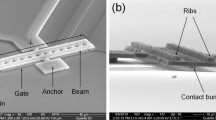Abstract
An active mechanism to retrieve the functionality of RF-MEMS ohmic switches after stiction takes place is discussed. The mechanism exploits a micro-heater, embedded within the switch topology, to induce restoring forces on the stuck membrane, triggered by thermal expansion, when an electric current is driven through it. The experimental investigations prove that driving pulsed (rather than DC) current into the heater enables a successful release of the tested RF-MEMS stuck devices. The release of stuck RF-MEMS ohmic switches is demonstrated for a cantilever-type micro-relay. The mechanism is suitable for a large variety of switch topologies, and can be embedded with small changes and effort within most of the already existing RF-MEMS ohmic switches, increasing, in turn, their reliability.





Similar content being viewed by others
References
Almeida L, Ramadoss R, Jackson R, Ishikawa K, Yu Q (2006) Study of the electrical contact resistance of multi-contact MEMS relays fabricated using the MetalMUMPs process. IOP J Micromech Microeng (JMM) 16:1189–1194. https://doi.org/10.1088/0960-1317/16/7/011
Amerasekera A, Duvvury C (2002) ESD in silicon integrated circuits. Wiley, Hoboken. https://doi.org/10.1002/0470846054
Belkadi N, Nadaud K, Hallepee C, Passerieux D, Blondy P (2020) Zero-level packaged RF-MEMS switched capacitors on glass substrates. IEEE J Microelectromech Syst (JMEMS) 29:109–116. https://doi.org/10.1109/JMEMS.2019.2949949
Chen K, Kovacs A, Peroulis D (2010) Anti-biased RF MEMS varactor topology for 20–25 dB linearity enhancement. In: Proceedings of the IEEE MTT-S International Microwave Symposium, pp 1142–1145. https://doi.org/10.1109/MWSYM.2010.5517852
de Los Santos HJ (1999) Introduction to microelectromechanical (MEM) microwave systems. Artech House Publishers, Boston
Goggin R, Fitzgerald P, Stenson B, Carty E, McDaid P (2015) Commercialization of a reliable RF MEMS switch with integrated driver circuitry in a miniature QFN package for RF instrumentation applications. In: Proceedings of the IEEE MTT-S International Microwave Symposium, pp 1–4. https://doi.org/10.1109/MWSYM.2015.7166959
Hikmat OF, Mohamed Ali MS (2017) RF MEMS inductors and their applications—a review. IEEE J Microelectromech Syst (JMEMS) 26:17–44. https://doi.org/10.1109/JMEMS.2016.2627039
Iannacci J (2015) RF-MEMS: an enabling technology for modern wireless systems bearing a market potential still not fully displayed. Springer Microsyst Technol 21:2039–2052. https://doi.org/10.1007/s00542-015-2665-6
Iannacci J (2018) RF-MEMS technology as an enabler of 5G: Low-loss ohmic switch tested up to 110 GHz. Elsevier Sens Actuat A Phys 279:624–629. https://doi.org/10.1016/j.sna.2018.07.005
Iannacci J (2020) RF MEMS for 5G applications—a reconfigurable 8 bit power attenuator working up to 110 GHz. Part 2—experimental characterisation of the RF behaviour. Springer Microsyst Technol 26:689–700. https://doi.org/10.1007/s00542-019-04604-y
Iannacci J, Faes A, Repchankova A, Tazzoli A, Meneghesso G (2011) An active heat-based restoring mechanism for improving the reliability of RF-MEMS switches. Elsevier Microelectron Reliab 51:1869–1873. https://doi.org/10.1016/j.microrel.2011.06.019
Iannacci J, Repchankova A, Faes A, Tazzoli A, Meneghesso G, Dalla Betta GF (2010) Enhancement of RF-MEMS switch reliability through an active anti-stiction heat-based mechanism. Elsevier Microelectron Reliab 50:1599–1603. https://doi.org/10.1016/j.microrel.2010.07.108
Iannacci J (2013) RF passive components for wireless applications. In: Uttamchandani D (ed) Handbook of MEMS for wireless and mobile applications. Woodhead Publishing, Cambridge. https://doi.org/10.1533/9780857098610.1.100
Jensen BD, Chow LL-W, Huang K, Saitou K, Volakis JL, Kurabayashi K (2005) Effect of nanoscale heating on electrical transport in RF MEMS switch contacts. IEEE J Microelectromech Syst (JMEMS) 14:935–946. https://doi.org/10.1109/JMEMS.2005.856653
Kuenzig T, Iannacci J, Schrag G, Wachutka G (2012) Study of an active thermal recovery mechanism for an electrostatically actuated RF-MEMS switch. In: Proceedings of the International Conference on Thermal, Mechanical and Multi-Physics Simulation and Experiments in Microelectronics and Microsystems (EuroSimE 2012) 1/7–7/7. https://doi.org/10.1109/ESimE.2012.6191766
Pal J, Zhu Y, Lu J, Dao D, Khan F (2016) High power and reliable SPST/SP3T RF MEMS switches for wireless applications. IEEE Electron Device Lett 37:1219–1222. https://doi.org/10.1109/LED.2016.2592539
Papaioannou GJ, Papapolymerou J (2007) Dielectric charging mechanisms in RF-MEMS capacitive switches. In: Proceedings of the European Microwave Integrated Circuit Conference (EuMIC), pp 359–362. https://doi.org/10.1109/EMICC.2007.4412723
Tabata O, Tsuchiya T, Brand O, Fedder GK, Hierold C, Korvink JG (2007) Reliability of MEMS. Wiley, Hoboken
Tazzoli A, Peretti V, Autizi E, Meneghesso G (2008) EOS/ESD Sensitivity of Functional rf-MEMS Switches. In: Proceedings of the EOS/ESD 2008–2008 30th Electrical Overstress/Electrostatic Discharge Symposium, pp 272–280
Varadan VK, Vinoy KJ, Jose KA (2003) RF mems & their applications. Wiley, Hoboken. https://doi.org/10.1002/0470856602
Author information
Authors and Affiliations
Corresponding author
Additional information
Publisher's Note
Springer Nature remains neutral with regard to jurisdictional claims in published maps and institutional affiliations.
Rights and permissions
About this article
Cite this article
Iannacci, J. An active heat-based restoring mechanism for high reliability RF-MEMS switches. Microsyst Technol 27, 183–187 (2021). https://doi.org/10.1007/s00542-020-04936-0
Received:
Accepted:
Published:
Issue Date:
DOI: https://doi.org/10.1007/s00542-020-04936-0




